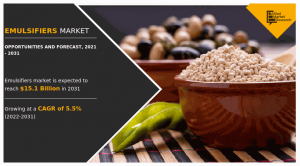Emulsifiers Market Outlook, Regional Overview, Business Strategies and Industry Size Forecast to 2031
Significant advancements in emulsion science that lead to improvement in product quality & efficiency & minimization of processing time drive the growth.
WILMINGTON, DE, UNITED STATES, October 1, 2025 /EINPresswire.com/ -- Emulsifiers Market size was generated $8.9 billion in 2021, and is expected to generate $15.1 billion by 2031, and witnessing with a CAGR of 5.5% from 2022 to 2031.Significant advancements in emulsion science that lead to improvement in product quality & efficiency and minimization of processing time and usage of natural emulsifiers in culinary items drive the growth of the global emulsifiers market. However, rise in usage of synthetic emulsifiers that make fatal impact on the consumer health by lowering down the diversity of gut flora and raising the risk of obesity and chronic diseases limit the market growth. On the other hand, the availability of semi-synthetic emulsifiers create new opportunities in the coming years.
Download Sample Report at: https://www.alliedmarketresearch.com/request-sample/A16961
The global emulsifiers market is expected to remain influenced by the growing demand for processed food & beverages across the globe, especially, in the Asia-Pacific region. Furthermore, the introduction of clean label food emulsifiers, owing to the increase in concern of millennials toward food transparency has been striking a chord for the leading market players in the global market.
Emulsifiers are Food and Drug Administration (FDA)-authorized food ingredients that aid in the combination of goods containing insoluble food components, such as oil and water. Emulsifiers are found in packaged and convenience foods such as mayonnaise, margarine, meats, ice cream, salad dressings, and chocolate. They can be synthesized or found naturally. Many emulsifiers used today are hydrocolloids, which are naturally produced. Hydrocolloids are thickening chemicals that maintain the structure, texture, taste, and shelf life of numerous food items. Owing to the sheer food texture and consistency generated by hydrocolloids, they are commonly referred to as gums. Emulsifiers derived from plants, animals, and aquatic sources are examples of hydrocolloids. Hydrocolloids derived from plants include locust bean gum, carrageenan, pectin, and starch, whereas hydrocolloids derived from animals include crustacean shell chitosan. Hydrocolloids, such as xanthan gum, may also be derived from microbial sources, and food ingredients such as mustard, oil, salt, egg yolk, and vinegar can also be used as emulsifiers. Some hydrocolloids have been proven to decrease cholesterol, enhance insulin function, act as prebiotics, and are high in fiber.
Buy This Research Report: https://www.alliedmarketresearch.com/emulsifiers-market/purchase-options
With the evolution of technology, industrial businesses are adopting new sources of emulsifiers to improve product quality, boost efficiency, and minimize processing time. For decades, emulsion technology has been used in the food industry to produce a wide range of products such as homogenized milk, creams, dips, dressings, sauces, desserts, and toppings. Significant advances in emulsion science, on the other hand, have lately resulted in revolutionary approaches for improving food quality and usability. Silica particles, wheat protein microgels, pea protein microgels, and other new advancements in emulsion technologies are assisting producers to bind the chemicals effectively, lowering the time required to complete the process, which is expected to fuel the emulsifiers market growth.
Starch is the most common type of carbohydrate consumed by humans. It is a plentiful, inexpensive, naturally occurring, and easily accessible basic food. Textiles, medicines, paper manufacturing, bioplastics, and many more sectors use it extensively. The use of starch has been witnessed to increase significantly in food processing, where it functions as both a stabilizer and an emulsifier to improve food quality. Long-term stabilization in food emulsion systems is ascribed to starch-based emulsifiers derived from micro and nanoparticles, hence increasing food structure and storage stability. These starch-based emulsifiers were created using a variety of processes, including hydrolysis, cold gelatinization, dissolution-precipitation, sedimentation, encapsulation, and the addition of hydrophobic components. As a result, starch-based emulsifiers that successfully bind emulsion interfaces are produced. These emulsifiers effectively stabilized pickering emulsions, which are well-known for their high stability. The increase in usage of starch-based emulsifiers is expected to provide emulsifiers market opportunity for growth.
For Purchase Enquiry: https://www.alliedmarketresearch.com/purchase-enquiry/A16961
The global emulsifiers market is segmented into source, application, and region. On the basis of source, the market is categorized into plant, animal, and synthetic. By application, it is fragmented into food & beverages, personal care & cosmetics, pharmaceuticals, and others. Region wise, it is analyzed across North America (the U.S., Canada, and Mexico), Europe (Germany, UK, France, Italy, Spain, and the rest of Europe), Asia-Pacific (China, India, Japan, Australia, South Korea, and rest of Asia-Pacific), and LAMEA (Brazil, Turkey, South Africa, Argentina, and rest of LAMEA).
Based on region, North America contributed the highest market share in terms of revenue in 2020, accounting for more than one-third of the global emulsifiers industry, and is expected to maintain its dominance in terms of revenue by 2031. This is attributed to high production and consumption of food, beverages, pharmaceuticals, and cosmetics and the availability of different variants of emulsifiers in various countries of the region. However, Asia-Pacific is projected to portray the fastest CAGR of 7.1% during the forecast period. This is due to rise in demand for emulsifiers from companies of different sectors to increase their production to cater to the market demand.
Leading Market Players
Akzonobel N.V.
Archer Daniels Midland
BASF SE
Cargill Incorporated
Clariant AG
Dow DuPont
Evonik Industries AG
Kerry Group
Koninklijke DSM N.V.
Solvay S.A.
Trending Reports:
Allulose Market: https://www.alliedmarketresearch.com/allulose-market-A16557
Protease Market: https://www.alliedmarketresearch.com/protease-market-A12830
Microgreens Market: https://www.alliedmarketresearch.com/microgreens-market-A08733
David Correa
Allied Market Research
+ + +1 800-792-5285
email us here
Visit us on social media:
LinkedIn
Facebook
YouTube
X
What Sets Us Apart ? - Allied Market Research
Legal Disclaimer:
EIN Presswire provides this news content "as is" without warranty of any kind. We do not accept any responsibility or liability for the accuracy, content, images, videos, licenses, completeness, legality, or reliability of the information contained in this article. If you have any complaints or copyright issues related to this article, kindly contact the author above.

